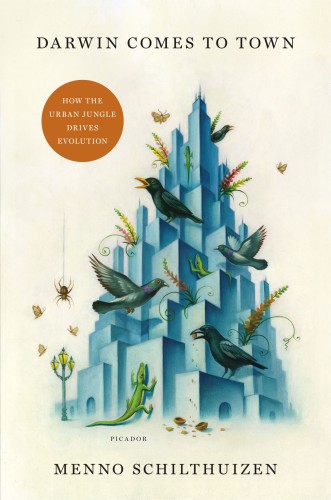
Darwin Comes to Town
How the Urban Jungle Drives Evolution
- اطلاعات
- نقد و بررسی
- دیدگاه کاربران
نقد و بررسی

February 15, 2018
An appealing argument that "we must embrace and harness the evolutionary forces that are shaping novel ecosystems right here, right now, and work toward allowing nature to grow in the hearts of our cities."In this delightful account by Schilthuizen (Evolutionary Biology/Leiden Univ.; Nature's Nether Regions: What the Sex Lives of Bugs, Birds, and Beasts Tell Us About Evolution, Biodiversity, and Ourselves, 2014, etc.), the senior research scientist at Naturalis Biodiversity Center in the Netherlands, readers who assume that pigeons, cockroaches, and rats are the only representatives of city biology will learn that it is far more complex. Typical British mosquitoes feed on birds, mate in swarms, and hibernate during winter. When the London underground appeared 150 years ago, many moved down into the tunnels, adapted, and evolved into species that feed on humans, mate as individuals, and remain active throughout the year. Darwin believed that natural selection works too slowly to be observed, but this "drives home the fact the evolution is not only the stuff of dinosaurs and geological epochs. It can actually be observed here and now!" This is the first of a steady stream of ingenious examples and research results that bolster the author's point that cities produce a unique, accelerated evolutionary environment. For example, birds adjust their calls to a higher pitch to be heard over the low-frequency roar of traffic. Awash with unfamiliar foods, shelters, and dangers, cities reward imagination, exploration, and problem-solving, so creatures normally shy in the wild become bold. The author points out urban ecosystems are becoming increasingly homogenized--e.g., 80 percent of herbs growing in the tiny islands of soil around street trees are identical to those in Europe.An expert romp through urban natural history, which, despite the absence of glamorous megafauna, turns out to be a turbulent, hothouse ecosystem whose life is evolving before our eyes.
COPYRIGHT(2018) Kirkus Reviews, ALL RIGHTS RESERVED.

Starred review from April 9, 2018
In a conversational style as appealing as it is informative, Schilthuizen (Nature’s Nether Regions), an evolutionary biologist at Leiden University in the Netherlands, explores myriad ways in which plants and animals have adapted to modern urban environments. Given the dramatic increase in urbanization that’s currently underway—“by 2030, almost 10 percent of all people on earth will live in only 41 megacities”—Schilthuizen is both realistic and optimistic in calling these environments “an exciting, novel ecological phenomenon.” Schilthuizen’s examples are fascinating, from changes in the immune systems of bobcats living in Hollywood, Calif., to the catfish in Albi, France, that have learned to leap out of the water, grab pigeons frolicking on the beach, and drag them beneath the surface to be eaten “in a few large gulps.” The changes scientists have observed, coupled with habitat fragmentation, “may be enough to start the splitting of the gene pools, and incipient urban speciation.” Schilthuizen is careful throughout to distinguish between true evolutionary changes and learned behaviors passed between individuals. He also does a superb job of introducing important ecological principles along the way, leaving readers with a fascinating question: “Can we harness the power of urban evolution to use it to make more livable cities for the future?”

April 15, 2018
Schilthuizen (evolutionary biology, Leiden Univ.; Frogs, Flies and Dandelions) explores the premise that evolution can happen more quickly than even Charles Darwin imagined. Species that evolve quickly can better adapt to human-made environments in order to survive. The author travels the world looking at plants and animals that have made such rapid adaptations. His fascinating observations include French urban catfish, which can leap from the water and pull pigeons underwater for a quick meal; city pigeons with darker feathers containing melanin, which detoxifies heavy metal pollutants; Mexican birds that line their nests with cigarette butts because nicotine acts to deter mites; and beach plants that live along northern inland highways that have been salted in the winter. Illustrating such ideas as hard and soft selection, plasticity, and epigenetics, the author makes scientific concepts accessible to average readers. With his main focus on human-induced rapid evolutionary change, he notes that humans are a hyperkeystone species, forcing other living beings to adapt to us. VERDICT This engaging book would be perfect for anyone who enjoys learning about the diverse creatures who share our world.--Caren Nichter, Paul Meek Lib., Univ. of Tennessee at Martin
Copyright 2018 Library Journal, LLC Used with permission.

March 15, 2018
One of the hallmarks of Darwin's original theory of evolution is the notion that adaptive changes in plants and animals happen slowly, usually over hundreds and thousands of years. Yet, according to Dutch evolutionary-biologist Schilthuizen, who provides an abundance of eye-opening evidence here, the dynamic ecosystems of heavily populated cities can spur everything from garden herbs and insects to crows and coyotes to evolve much more quickly. Schilthuizen begins by revealing an astonishing, little-known fact about beetles: many species have learned the biological trick of emitting ant pheromones so that they can occupy ant nests and pilfer food. He then demonstrates how similar opportunistic adaptions have appeared in urban-dwelling creatures within mere generations of their more rural cousins, including mosquitoes that now breed in London's underground to feed on commuters, Japanese crows that use passing traffic to crack nuts, and spiders that weave their webs around streetlights to snare light-besotted moths. Replete with fascinating facts and written in delightfully lively prose, Schilthuizen's work will appeal to nature lovers and popular-science fans.(Reprinted with permission of Booklist, copyright 2018, American Library Association.)




دیدگاه کاربران